

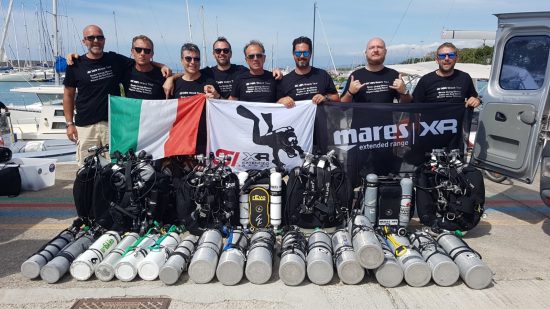
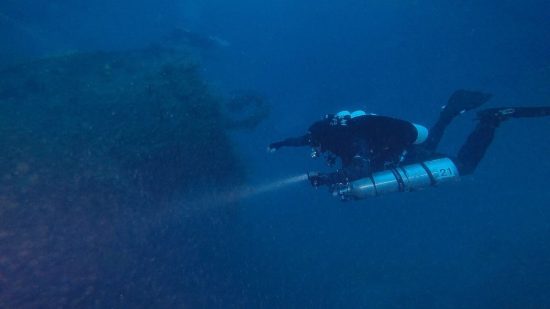
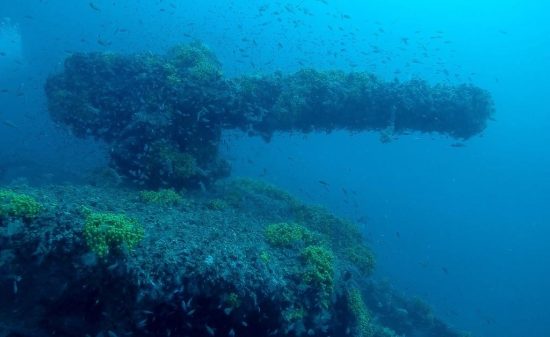
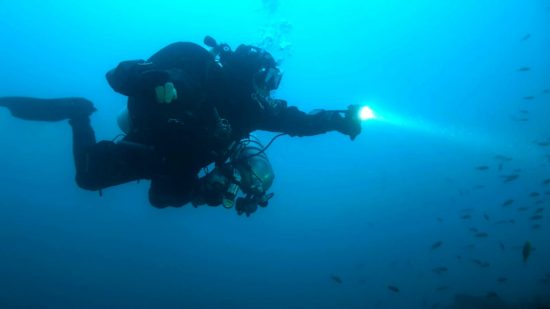
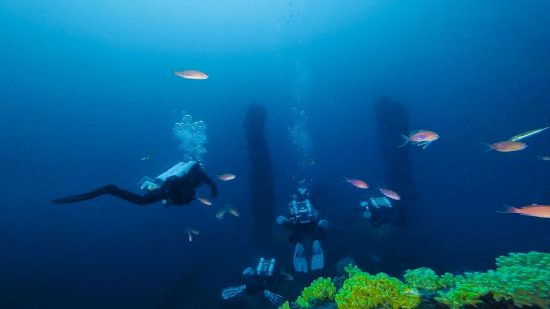
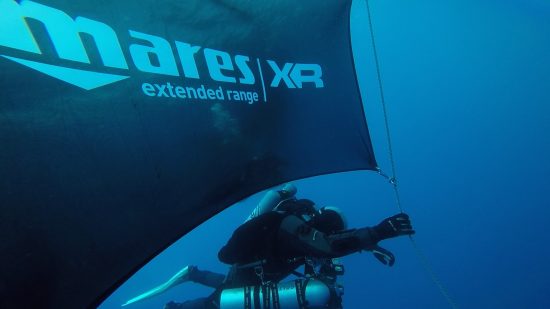
When my friend Giorgio Canepa told me about his idea to plan a week of dives, visiting some of the most interesting wrecks in the seas of southern Italy, I immediately decided to participate. The opportunity to be part of a team of professional divers and share in this unique experience was exciting, and as we thought about the places to visit and the divers to involve, I began to fantasize and plan the details. That’s how the first edition of the XR Wreck Tour was born, with the aim of bringing together the best SSI Extended Range divers to promote and consolidate the Mares XR movement within the dive community.
Myself and Giorgio left Pisa for Brindisi on Thursday the 31st of May. Despite it being almost midnight, Stefano Levanto, owner of Scuba Diving Otranto as well as a member of our team, was at the airport to greet us on our arrival. His contribution was vital as he perfectly organized the first stop, which took place in Otranto with his dive center, and because he made a van available to the team in which we travelled the length and breadth of southern Italy.
The next day, Giorgio and I did a warm-up dive at Punta Palascia during which we tested and prepared our rEvo rebreathers. In the afternoon, we first went to Lecce station to collect Roberto Bottini and Andrea di Vaira who had arrived by train from Milan, and then on to Brindisi airport where we met Florent Locatelli. The team for the first dive of the tour was complete!
On the morning of Saturday the 2nd of June the XR Wreck Tour 2018 officially started with a dive to the wreck of the Adonis, an almost 100 meter-long Honduran merchant steam ship.
In February 1960 it had just left for Greece with its load when, due to an exploding boiler, it sent out a mayday signal. The tug boat Ardimentoso left from the port of Brindisi but found it had already sunk. Despite an attempt to tow it, it ended up on the sandy seabed at a depth of 72 meters, no more than a couple of miles from the port of Otranto, on the Adriatic side of Salento, in perfect sailing trim.
The Strait of Otranto is often hit by strong currents, and as soon as we enter the water we are aware of it. The descent is very challenging and takes strict planning and above all close contact with the reference line and dive buddy. Visibility is unfortunately low and the outline of the ship can be seen little before reaching the quarterdeck, at a depth of around 55 meters. We move towards the bow along the main deck and then enter the hold, looking for the remains of the ship’s cargo.
Time passes relentlessly and we return towards the stern, visiting the left side where we reach the maximum depth. The bulwark is intact and populated by enormous starfish. We return along the guard rail of the main deck, reaching our starting point, where we find the reference line sitting near the gaping hole produced by the exploding heater which had caused the boat to sink.
The planned bottom time was up. Me and Stefano, my dive buddy for most of the next dives, start the long ascent with decompression stops. Endless minutes await us attached to the line which violently jerks due to the current.
The next day we cross the heel of Italy, moving towards the Ionian side to Santa Caterina di Nardò where we join the team of Andrea Costantini, owner of the Diving Service Costa del Sud which offers us a logistic base for the second stop of our tour.
The steamer Caterina Madre, at around 100 meters long and 15 meters wide, set sail in 1904 from Thornaby on Tees in the United Kingdom. After a few changes in ownership (during which it took its latest name) it was taken by the Italian Navy in the Second World War and armed with an imposing anti-aircraft cannon on the stern. During navigation in the seas of southern Italy it hit a mine which sunk it off the coast of Gallipoli.
The wreck was tracked down and discovered by a team of divers led by Andrea Costantini around 10 years ago and, thanks to an accurate historical reconstruction using wartime communications, it was identified. This giant of the sea lays on a sandy seabed at around 77 meters, in perfect sailing trim and in one piece.
The northern wind which had refreshed Otranto the day before and forced us to fight against the current at Santa Caterina is impalpable. In the scorching heat we load all our gear onto the dive center’s new boat to reach our dive spot.
The sea is flat, there’s no trace of a current and already in the first few meters descent we realize the visibility will be wonderful. The steamship appears in all its majesty well before we reach it. It is completely colonized by yellow sponges which make the scene very evocative.
The wreck is enveloped by a myriad of damselfish which dance in groups and then scatter when the beams of light from our torches shine on them. On the deck, sitting on the bitts, huge scorpionfish remain blasé to our passing, whilst at the stern schools of snappers speed by on the hunt.
At the deepest point, on the sand, ten meters or so from the large 4-blade propeller, we chance upon one of the mines which caused the boat to sink.
 Underwater Tales by Stefano Sibona
Underwater Tales by Stefano Sibona 4th September 2018
4th September 2018 Otranto, LE, Italia
Otranto, LE, Italia 